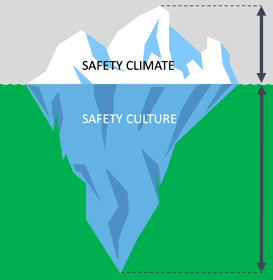 Safety culture and safety climate are two critical concepts in Occupational Health and Safety (OHS). Safety culture refers to the shared values, beliefs, and practices that shape an organisation's approach to safety. On the other hand, safety climate refers to the perceptions and attitudes of employees towards safety within an organisation. While safety culture focuses on the underlying values and beliefs that drive safety, safety climate is more concerned with how employees perceive and behave towards safety in their day-to-day work.
Safety culture and safety climate are two critical concepts in Occupational Health and Safety (OHS). Safety culture refers to the shared values, beliefs, and practices that shape an organisation's approach to safety. On the other hand, safety climate refers to the perceptions and attitudes of employees towards safety within an organisation. While safety culture focuses on the underlying values and beliefs that drive safety, safety climate is more concerned with how employees perceive and behave towards safety in their day-to-day work.
Strong Evidence for Safety Climate and Weak Evidence for Safety Culture
According to the OHS Body of Knowledge's recent chapter on Organisational Culture, there is strong evidence for a relationship between safety climate and OHS outcomes. In contrast, the evidence for safety culture to improve OHS outcomes is weak. This finding suggests that OHS professionals should emphasise safety climate over safety culture when seeking to improve safety outcomes in the workplace.
Safety Culture or Culture of Safety?
One of the key findings of the OHS Body of Knowledge chapter is that the construct of safety culture is considered a myth. The authors suggest that it is preferable to refer to a 'culture of safety' defined as how things are done in the organisation. This definition relies on leadership practices, organisational structure, organisational practices, and management systems to improve OHS outcomes. Workers are in the best position to judge if how things are done in the organisation is working.
Safety Culture Maturity Models and Their Effectiveness
Since the 2014 publication of the first Organisational Culture chapter, there has been an increased use of safety culture maturity models to diagnose an organisation's safety culture. However, the effectiveness of these models in improving safety performance has yet to be demonstrated. While these models can be helpful in identifying areas for improvement, OHS professionals need to be cautious when relying on them as the sole solution for improving safety outcomes.
The Link Between Safety Culture Interventions and Safety Performance
Despite the popularity of safety culture interventions in industry, a conclusive link has yet to be found between safety culture interventions and safety performance. While some industry evidence suggests that a focus on safety culture improves OHS outcomes, OHS professionals may be divided in their opinions of the usefulness of the safety culture construct. Thus, evaluating the effectiveness of interventions tailored to specific organisational needs and developing appropriate organisational structures and practices to deliver successful interventions is essential.
Closing the Research-to-Practice Gap in OHS
The authors of the OHS Body of Knowledge chapter suggest conflicting views on the usefulness of the safety culture construct exist both within research and the OHS profession and between researchers and OHS professionals. This situation highlights the need to close the research-to-practice gap in OHS. OHS professionals should focus on intervention evaluation, safety climate as a tool for measuring the effectiveness of interventions, developing organisational structures and practices for delivering successful interventions, and remembering all the while that safety climate and safety culture are but metaphors for understanding the same thing – how to create a healthy and safe working environment as the law requires.
Measuring Safety Climate: Surveys and Interviews
One way to measure safety climate is through surveys or interviews. These tools can provide valuable insights into the perceptions and attitudes of employees towards safety within the organisation. This information can then be used to identify improvement areas and develop strategies to address any issues identified. By understanding and addressing these perceptions, OHS professionals can improve the organisation's overall safety performance.
Tailoring Interventions to Specific Organisational Needs
OHS professionals should understand that safety culture interventions are not a one-size-fits-all solution. The lack of a conclusive link between safety culture interventions and safety performance suggests that these interventions may only be effective in some organisations. Thus, OHS professionals should focus on evaluating the effectiveness of interventions and developing organisational structures and practices tailored to their organisation's specific needs. This approach can lead to more successful interventions and better overall safety outcomes.
Creating a Culture Where Safety is a Shared Value
It is crucial for OHS professionals to understand that the concept of safety culture is complex and multifaceted. It is not just about implementing safety policies and procedures but also about creating a culture where safety is a shared value and integrated into the organisation's everyday operations. This can be achieved through strong leadership, effective communication, and employee engagement.
Take Charge of Your Workplace's Safety with Our OHS Professional Support
In conclusion, understanding the findings of the OHS Body of Knowledge chapter on Organisational Culture is critical for OHS professionals seeking to improve safety outcomes in the workplace. By emphasising safety climate over safety culture, evaluating the effectiveness of interventions, and developing organisational structures and practices tailored to specific needs, OHS professionals can create a culture where safety is a shared value, embedded into the organisation's everyday operations.
Measuring safety climate through surveys and interviews can also provide valuable insights to identify areas for improvement. Our OHS professionals can help you understand the relationship between safety climate and OHS outcomes, evaluate your current interventions, and develop new organisational structures and practices tailored to your needs.
With our expertise and experience, we can help you create a safe and healthy working environment that complies with legal requirements. Contact us today to take the first step in ensuring your workplace's safety.


